How beer sludge is being turned into vegan milk and leather
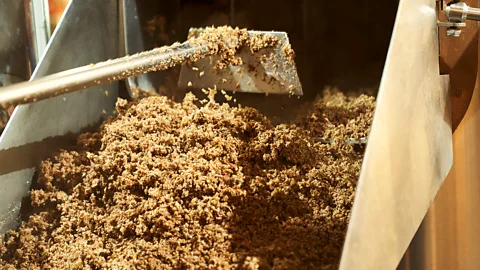 Getty Images
Getty ImagesScientists and industry are finding unusual new uses for brewers' spent grain – the beer industry's largest waste product.
Ponder the idea of a beer well-brewed and enthusiastic drinkers at least are likely to imagine a pint glass filled to the brim with golden nectar.
What they probably won't picture is the mountains of wet sticky shavings that pile up as the largest waste material of brewing beer.
This is what's known as brewers' spent grain, and there is an awful lot of it. Around 200g (7oz) is produced for every litre of beer brewed. Globally some 37 million tonnes is produced each year – equivalent to the weight of around 340 double-decker buses per hour. And as we drink more beer – sales are expected to rise by a third in the next seven years – only more and more will be churned out.
Most brewers' spent grain, around 70% of it, is currently repurposed as cattle feed, while 10% is used to make biogas. Around a fifth is simply sent straight to landfill – at an additional cost to breweries – where it rots and releases methane into the atmosphere.
But inside this beer by-product there are a mountain of useful chemicals to tap, including lots of protein. Researchers and companies are now beginning to explore how these could be put to better use.
Swiss start-up Upgrain is one of these. In 2024, it launched a processing system to turn brewers' spent grain into protein and fibre, passed as fit for human consumption by the Food and Drug Administration in the US and the European Food Safety Authority (brewers' spent grain is, after all, still just grain). The system comes ready for installation on brewery premises: shipping container-sized for micro-breweries and a much larger unit for the likes of Brauerei Locher, Switzerland's second biggest brewer, which opened in September 2024 and is now building Europe's largest onsite facility.
William Beiskjaer, Upgrain's co-founder, argues brewers spent grain is a "kind of hidden treasure in terms of sustainable and healthy nutrition". He says it could help to tackle rising global demand for protein. "There's more and more demand for our foods to be enhanced, especially to get more protein and fibre in our diets," he says.
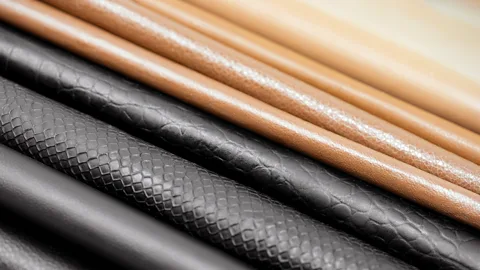 Arda Biomaterials
Arda BiomaterialsUpgrain and other producers such as Agrain in Denmark and BiaSol in Ireland are already selling brewers' spent grain protein and fibre extract to food manufacturers for inclusion in baked goods, pizzas, granola and even crisps. It's also being used in plant-based meat alternatives, such as those launched last year by the Swiss supermarket chain Migros, and in a coffee created by Singapore-based company Prefer.
Hype Metre
Brewers' spent grain is a rich source of nutrients which is arguably wasted as cattle feed and produces methane when it ends up in landfill. A host of start-ups are now using it to make everything from vegan barley milk and leather to baked goods, crisps and even coffee; it even has potential to be used in areas like construction, cosmetics and paper.
Not all these products are yet past the early stages of development, and products could struggle to see widespread consumer acceptance. Brewers' spent grain also uses lots of energy to process and spoils fast. Scientists and developers are already working to overcome these issues, however.
Huge brewers such as the Belgium-based Anheuser-Busch InBev and Chicago-based Molson Coors have even created their own vegan barley milk spin-offs made from spent grain. Molson Coors claims its Golden Wing product has a "rich and creamy taste" and 25% less sugar than most oat milks.
"This is an exciting new idea," says Beiskjaer. "If you'd have said to me four years ago that brewers' spent grain would be a [human] food source, I'd have asked what you were talking about. But we're on the way to seeing upcycled BSG as a staple in the food industry."
Beiskjaer says he can see why some people may be squeamish about the notion of "upcycled food". "But we have to get across the idea that brewers' spent grain is not a waste product," he says. "It's being saved from being a waste product."
Making use of this waste product to make plant-based protein could in theory also free up the small amounts of arable farmland used to grow wheat, soy and pea for human protein – or, if it replaced meat, a far larger amount of land. Äio, a biotech start-up based in Tallin, Estonia is using brewers' spent grain and other food and agricultural waste products to develop an alternative to palm oil, a major driver of deforestation in Indonesia and other countries. To do this Äio grows fatty acid-making microorganisms and applies these to a fermentation process not dissimilar to that used in brewing beer.
There are some caveats to using brewers' spent grain in food, however. Since it is loaded with moisture and so spoils quickly, using it close to where it is produced is essential. This is one reason why a good proportion ends up in landfill: there's not enough demand from local farmers to meet supply. That dampness risks mould and microbial infection. In fact, says Beiskjaer, "it becomes the perfect environment for bacteria unless it's quickly preserved". Techniques for making preservation easier are now being explored.
But nutrition isn't the only area where spent grain could make an impact.
Brett Cotten concedes that early efforts by his young London-based company, Arda Biomaterials, to create leather-alternatives from brewers' spent grain resulted in something more akin to a flapjack.
But the start-up has since successfully used supramolecular chemistry to make several proteins from brewers' spent grain that mimic the animal proteins in leather, resulting in a strong and supple alternative. The colour reflects the spent grain used, he says. "Guinness and stouts make for a naturally black material, IPAs and lagers more mid-browns."
Cotten argues that to date many leather alternatives have either not been as environmentally sound as promised or are not scalable enough to replace animal leather. In contrast, he says, Arda's first test material was made in a home lab using standard kitchen equipment, using the abundant feedstock that is brewers' spent grain.
So far staff at the company and a local brewery have wear-trialled this new material with bags and cardholders. Current production is at lab scale, but a pilot facility set to open in London in 2025 will allow it to produce up to 1,500 sq m (16,000 sq ft) a year, the company says.
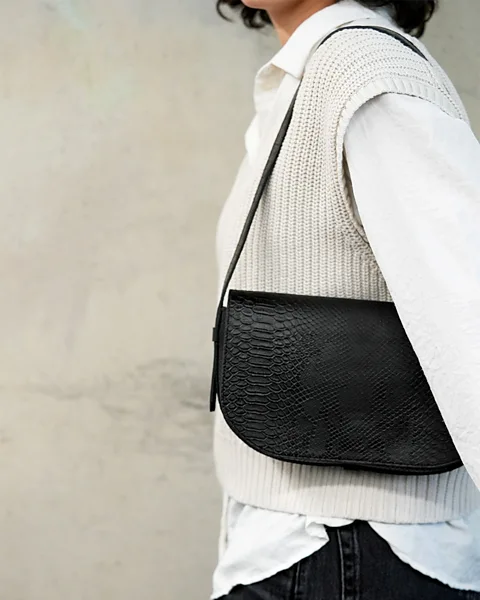 Arda Biomaterials
Arda BiomaterialsArda's own estimates suggest that, were a facility tied to a single major brewing plant – the likes of one run by Heineken or InBev – all of the spent grain being produced by the plant could make for 5-10 million sq m (54,000-108 sq ft) of its mid-range faux-leather, suitable for use in fashion and the automotive upholstery industries. Tied to, say, three major brewing facilities, it could undercut the cost of both real and plastics-based synthetic leathers, it argues. Cotten estimates that just 10% of global brewers' spent grain output would satisfy the global demand for leather.
"Of course, the look and feel [of our material] is important, but so is scalability," says Cotten. "The fashion industry just wants a new option [to animal or current bioleathers]. And while it's often happy to work with a batch of proof-of-concept material for a small collection, you have to be able to produce at scale to be of real interest."
That comes with a cost, however. Processing brewers' spent grain typically involves mechanical methods – using high pressure and temperature and spinning the grain in a centrifuge – or the use of strong acids and alkalis, all of which are energy-intensive and can raise their own environmental questions. There is therefore an ongoing exploration of cheaper and more sophisticated methods to extract protein from spent grain, such as the use of bacteria and fungal enzymes to break down chemical bonds, for example.
Last year, a team in Singapore, funded by Heineken Asia, unveiled the use of fermentation to break down the chemical bonds in spent grain, which also resulted in the extracted protein – for use in foodstuffs – being richer in nutrients and fatty acids. In another step that might be widely applied, the researchers heated the spent grain using microwaves and found they could extract over 80% of its available protein content this way, the most harvested to date.
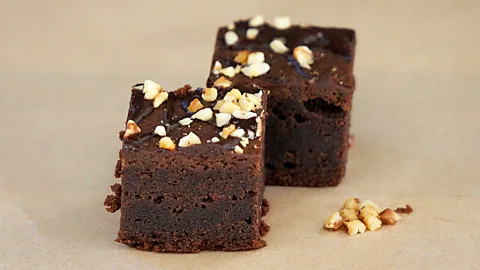 Upgrain
Upgrain"Using microwaves is a difficult challenge, in their energy requirements, efficiency and scalability," says William Chen, professor of food science and technology at Nanyang Technical University in Singapore. "But it's certainly possible to scale up [a microwave approach], or to find other ways of applying heat, through vibration, for example."
The overall objective is to move towards an "ever more functional, higher value products", he says. "And we should be doing the same with [other protein-rich waste products such as] soybean residue, for example," he adds.
Arda's experiments may prove to be just the first steps in exploring the potential of spent grain beyond the edible. Antioxidant-rich brewers' spent grain could provide an eco-friendly alternative to the chemicals used in cosmetics, for instance, or used to replace the virgin fibres used in paper making.
Rosa Arrigo, associate professor in inorganic chemistry at the University of Salford in the UK, says brewers' spent grain has a "niche composition that's rich in chemicals [that] certainly have potential to [in time] be used to produce new materials". Work at Salford to extract various organic compounds from brewers' spent grain is ongoing and Arrigo envisages these being used to make robust composite materials that could, for example, be bindable to the likes of concrete to make it stronger, more lightweight and more sustainable.
"Certainly there's a whole other layer to what brewers' spent grain could bring beyond protein extraction for food," says Arrigo. "Exactly what that is what we're now starting to examine." Doing this, though, could be expensive and complex, she adds. "So we need further investigation to understand really what we have here, and what's actually needed by industry: what's good enough in terms of its quality but also economically feasible."
The development of one such material is already underway: a group of researchers coordinated by University of Perugia, Italy, is currently working on a bioplastic derived from brewers' spent grain.
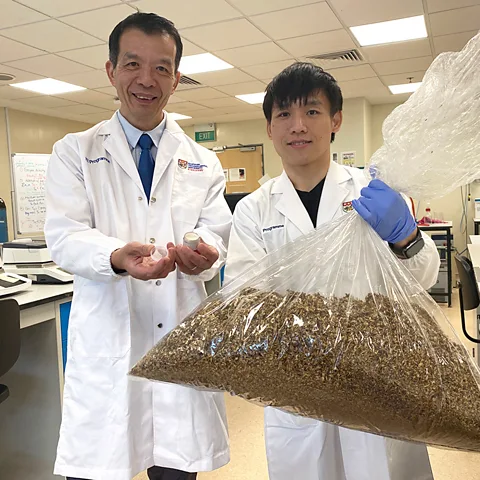 NTU Singapore
NTU SingaporeCurrently, spent grain usually needs to be dried before it can be further processed, which is both time and energy consuming. But the Perugia team has developed a means of processing it while wet, critical to developing a bioplastic that could improve on the mechanical properties of those already available. The so-called Polymeer project hopes to have its first product – perhaps a biodegradable film wrap that could be used in packaging and agriculture – within four years.
"I think the true potential of brewers' spent grain has been overlooked, because even when the protein is removed there's still a lot of [useful] waste, the likes of lignin and cellulose, that has the potential to be a raw material [for other purposes]," says Assunta Marrocchi associate professor in biotechnology at the University of Perugia and Polymeer's project coordinator. "And the extraction of its additional components seems to be possible by relatively easy, low energy methods."
But what really matters here she adds, is that "because almost everyone drinks beer, there's just so much of it to work with. It really is an incredible feedstock".
So, the next time you're in the pub, perhaps you'll find yourself considering how the undertaking that put the beer in your glass might just prove an unexpected game-changer to both our diets and the materials we use.
--
For essential climate news and hopeful developments to your inbox, sign up to the Future Earth newsletter, while The Essential List delivers a handpicked selection of features and insights twice a week.
